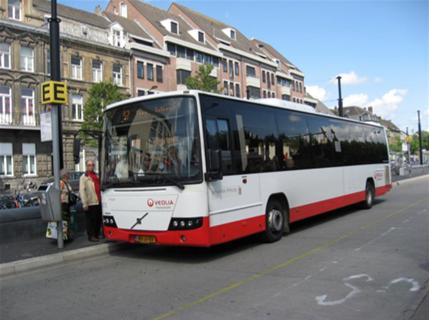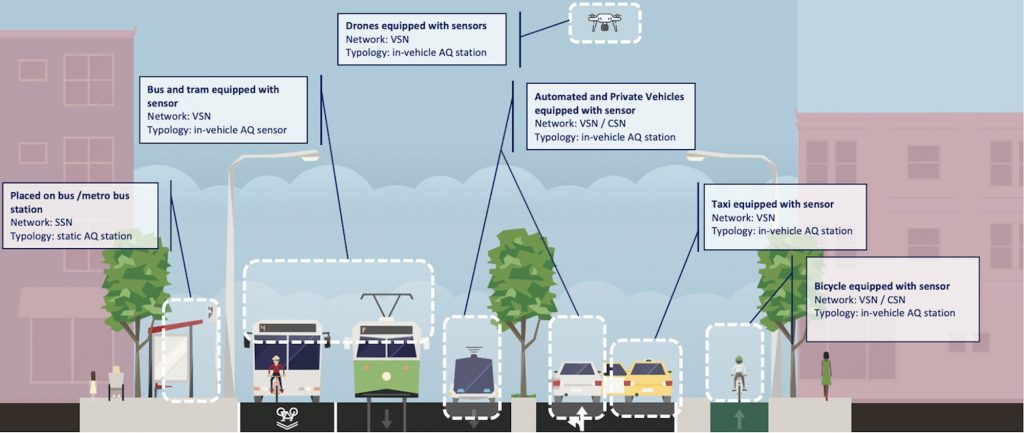Real-time hierarchical control and monitoring of urban traffic systems
 The introduction of Intelligent Transportation Systems (ITS) technologies and new sensing hardware promise significant progress in reducing the congestion level in cities. With respect to monitoring, reliable and efficient estimation of travel times and other performance measures is still not a wide spread accomplishment on arterials. The issue is not only that the existing monitoring infrastructure in arterials is less dense than freeways but also that arterial systems traffic dynamics are significantly different than these of freeways and fixed sensors cannot always give the required level of information. Thus, the two scientific aspects of (i) monitoring and (ii) controlling congestion in local arterials is the emphasis of the proposed work. This study aims in capitalizing both fixed and mobile sensors. The proposed methodology will provide for efficient estimation of travel time reliability measures. These performance measures will be an important tool to develop and test a different type of control of urban networks, a multi-level hierarchical control. The building block of our methodology is a sub-network with a Macroscopic Fundamental Diagram representation. A research challenge is to partition a network in homogeneous sub-networks with an MFD representation and to build a hierarchical feedback control network of multiple levels which may require different data granularity at each level. Another important aspect of this research is what level of monitoring is required to guarantee “observability” of the state of the system. The validation of the monitoring and control methodologies will be conducted in complex city-level scenarios using advanced micro-simulation software and data from field experiments.
The introduction of Intelligent Transportation Systems (ITS) technologies and new sensing hardware promise significant progress in reducing the congestion level in cities. With respect to monitoring, reliable and efficient estimation of travel times and other performance measures is still not a wide spread accomplishment on arterials. The issue is not only that the existing monitoring infrastructure in arterials is less dense than freeways but also that arterial systems traffic dynamics are significantly different than these of freeways and fixed sensors cannot always give the required level of information. Thus, the two scientific aspects of (i) monitoring and (ii) controlling congestion in local arterials is the emphasis of the proposed work. This study aims in capitalizing both fixed and mobile sensors. The proposed methodology will provide for efficient estimation of travel time reliability measures. These performance measures will be an important tool to develop and test a different type of control of urban networks, a multi-level hierarchical control. The building block of our methodology is a sub-network with a Macroscopic Fundamental Diagram representation. A research challenge is to partition a network in homogeneous sub-networks with an MFD representation and to build a hierarchical feedback control network of multiple levels which may require different data granularity at each level. Another important aspect of this research is what level of monitoring is required to guarantee “observability” of the state of the system. The validation of the monitoring and control methodologies will be conducted in complex city-level scenarios using advanced micro-simulation software and data from field experiments.
Movement Conflicts in multi-modal urban traffic systems: Modeling Congestion and developing more sustainable cities
 As cities around the world grow rapidly and more people and modes compete for limited urban space to travel, there is need to understand how this space is used for transportation and how it can be managed to improve accessibility. Our research seeks to shed some light in the modeling, planning and management of traffic flow for overcrowded cities with multimodal transport. We develop methodologies to model and understand the collective behavior for different types of multi‐modal systems, with emphasis in conflicts for the same road space (e.g. mixed traffic of buses and cars or vehicles searching for parking). Ultimately, the goal is to develop optimization tools on how to distribute city road space to multiple modes and to understand the level of accessibility for cities of different structures. We also investigate what type of real-time active traffic management schemes (congestion pricing, vehicle restriction, large scale traffic signal control) can improve mobility measures in a city. The accuracy of the developed models will be tested for different routes and different networks using real bus, signal, geometric and traffic data. Also, the models will be tested with a variety of different types of realistic multimodal networks using micro‐simulation.
As cities around the world grow rapidly and more people and modes compete for limited urban space to travel, there is need to understand how this space is used for transportation and how it can be managed to improve accessibility. Our research seeks to shed some light in the modeling, planning and management of traffic flow for overcrowded cities with multimodal transport. We develop methodologies to model and understand the collective behavior for different types of multi‐modal systems, with emphasis in conflicts for the same road space (e.g. mixed traffic of buses and cars or vehicles searching for parking). Ultimately, the goal is to develop optimization tools on how to distribute city road space to multiple modes and to understand the level of accessibility for cities of different structures. We also investigate what type of real-time active traffic management schemes (congestion pricing, vehicle restriction, large scale traffic signal control) can improve mobility measures in a city. The accuracy of the developed models will be tested for different routes and different networks using real bus, signal, geometric and traffic data. Also, the models will be tested with a variety of different types of realistic multimodal networks using micro‐simulation.
OPTIMUM: Optimized ITS-based Tools for Intelligent Urban Mobility
 In this project three leading research teams collaborate with the aims at developing innovative solutions for intelligent urban mobility to address the urban mobility challenges. The collaborating partners have complementary expertise and common vision and interest for ITS research. To achieve aforementioned objectives, the project is designed to harmonise the research program by exchange of information, ideas, resources etc between three strong research institutes in Switzerland, France and Australia. This effective way of learning will enhance the research capabilities of each partner by exchange of researchers with specialised knowledge. This cross-border and cross-disciplinary cooperation will strength the collaboration and mutual understanding and open new possibilities to promote new direction for application of ITS systems. The project addresses its research goals by dividing the research into three research oriented working groups (WG) as follows:
In this project three leading research teams collaborate with the aims at developing innovative solutions for intelligent urban mobility to address the urban mobility challenges. The collaborating partners have complementary expertise and common vision and interest for ITS research. To achieve aforementioned objectives, the project is designed to harmonise the research program by exchange of information, ideas, resources etc between three strong research institutes in Switzerland, France and Australia. This effective way of learning will enhance the research capabilities of each partner by exchange of researchers with specialised knowledge. This cross-border and cross-disciplinary cooperation will strength the collaboration and mutual understanding and open new possibilities to promote new direction for application of ITS systems. The project addresses its research goals by dividing the research into three research oriented working groups (WG) as follows:
Analysis, evaluation and recommendations for the Nice-Monaco Veolia bus system
 Veolia transfers about 1.5M passengers per year in the Nice-Monaco line using 3 different routing options. The majority of the demand is for the southern corridor. This demand consists of workers who live in Nice and work in Monaco, workers who live between Nice and Monaco and a large number of tourists. The tourists choose the Southern corridor because it provides many attractions during their trip. This line operates in a non-efficient way, as there is high level of congestion (a trip of 30min in the off-peak lasts for more than 60min in the peak) and high spatial heterogeneity in demand, which results in out-of-vehicle delays for passengers. The congestion spreads throughout the corridor and also at the entrance roads to Monaco and Nice. This project investigates this complex corridor, identify the causes of congestion and propose alternatives for more efficient transfer of passengers to their destinations. The research involves (i) Temporal and spatial estimation of bus and car travel times for all three alternatives, (ii) Temporal and spatial analysis of demand for buses and (iii) Evaluation of the alternatives. Among the alternatives we plan to investigate (i) separation of the southern route to 2 lines with possibly different stops, (ii) adjustment of the frequencies for the different lines and (iii) possibility of introducing a new line in the Middle corridor.
Veolia transfers about 1.5M passengers per year in the Nice-Monaco line using 3 different routing options. The majority of the demand is for the southern corridor. This demand consists of workers who live in Nice and work in Monaco, workers who live between Nice and Monaco and a large number of tourists. The tourists choose the Southern corridor because it provides many attractions during their trip. This line operates in a non-efficient way, as there is high level of congestion (a trip of 30min in the off-peak lasts for more than 60min in the peak) and high spatial heterogeneity in demand, which results in out-of-vehicle delays for passengers. The congestion spreads throughout the corridor and also at the entrance roads to Monaco and Nice. This project investigates this complex corridor, identify the causes of congestion and propose alternatives for more efficient transfer of passengers to their destinations. The research involves (i) Temporal and spatial estimation of bus and car travel times for all three alternatives, (ii) Temporal and spatial analysis of demand for buses and (iii) Evaluation of the alternatives. Among the alternatives we plan to investigate (i) separation of the southern route to 2 lines with possibly different stops, (ii) adjustment of the frequencies for the different lines and (iii) possibility of introducing a new line in the Middle corridor.  Principal investigator Nikolas Geroliminis
Principal investigator Nikolas GeroliminisCAROLINA: Real-time pollution City mAp thRough cOLlaborative sensIng aNd Analysis: Collaborative and dynamic urban air pollution monitoring
Air pollution is a global challenge and a major concern in major cities around the world. In order to set up and maintain an acceptable level of ambient Air Quality Monitoring System (AQMS) specific measures need to be taken. While networks of fixed measurement stations have been a quite accurate solution during the past years, the low spatial resolution of the collected data does not allow the assessment of the spatial variability of pollutants in detail while other drawbacks include their large size, high price and laborious maintenance.
It has been reported that an increase in network size of fixed stations can lead to increased complication, exponentially growing costs and effort for data analysis and visualization. Thus, engaging citizens into being part of a collaborative system of the emission monitoring infrastructure can contribute towards this direction, bringing different complexities, issues, challenges and opportunities than the static-based solution. During the CAROLINA project, we aimed to explore the current state of the art in air quality monitoring approaches and consider the inclusion of citizens into an open and collaborative process for an enriched air quality monitoring system. Thus, in order for citizens to become a vital part of this system and contribute towards the reduction of urban air pollution, the motivation and the way to attract and engage them was explored. Finally, based on the discussion around current and past projects with similar scopes to CAROLINA from the city of Istanbul, Turkey and the findings of the literature review, further opportunities and suggestions towards the deployment of such a system are provided.
The aims of the EPFL’s task can be summarized to:
- Exploration of the current state of the art in next generation monitoring techniques
- Consideration of the open collaboration approach for AQ modelling and monitoring
- Analysis on what should be the motivation, what should attract and how to engage citizens to actively contribute towards the reduction of urban air pollution
- Examination of the city of Istanbul as a specific case study based on the findings
Two important directions were discussed. The first one described the state-of-the-art and identified the main issues that should be taken into consideration by policy makers, researchers and practitioners during the first stages of the design and deployment a network of sensors. It is an important guide that not only categorises challenges and caveats but also identifies substantial opportunities to maximize the success rate of such a system. Compared to earlier approaches, a hybrid system is suggested the ideal solution using the latest powerful data fusion techniques and technological advancements. Since the low-cost sensors are still not flawless in terms of accuracy, calibration and collection of high-quality data should be the primary goal.
The second direction that is related to the engagement of the citizens to participate in an AQMS identified that some of the main concerns of the citizens’ participation include privacy, data quality and energy efficiency issues. Additionally, it is important to maintaining their engagement and participation throughout the data collection process is of major importance and can be guaranteed by quality feedback, economic or other incentives and technological support. Finally, as communities have been demanding a greater role in decision-making that affects their lives it is vital to communicate the results of such participation in a clear way.
The final part of the project discussed how the findings described above combined with the experience from current and past projects in the city of Istanbul, Turkey can be a unique opportunity for the successful deployment of a low-cost sensor system in a city like Istanbul.
In case you are interested in discussing about a dynamic and collaborative air pollution monitoring methodology for your city, send us an email.
This project is funded by EIT Urban Mobility, an initiative of the European Institute of Innovation and Technology (EIT). EIT Urban Mobility acts to accelerate positive change on mobility to make urban spaces more liveable. Learn more: eiturbanmobility.eu.
Sponsor EIT Urban Mobility

